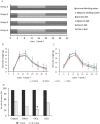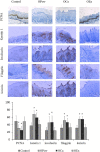Inhibition of 4NQO-Induced Oral Carcinogenesis by Dietary Oyster Shell Calcium
- PMID: 26293805
- PMCID: PMC5736080
- DOI: 10.1177/1534735415596572
Inhibition of 4NQO-Induced Oral Carcinogenesis by Dietary Oyster Shell Calcium
Abstract
Oyster has gained much attention recently for its anticancer activity but it is unclear whether calcium, the major antitumor ingredient in oyster shell, is responsible for the anticarcinogenic role of the oyster. To address this issue, C57BL/6 mice were fed with the carcinogen 4-nitroquinoline-1-oxide (4NQO, 50 µg/mL) and normal diet or a diet containing oyster powder, oyster calcium, or calcium depleted oyster powder. The tongue tissue specimens isolated from these mice were histologically evaluated for hyperplasia, dysplasia, and papillary lesions, and then analyzed for proliferation and differentiation markers by immunohistochemistry. The results showed that mice on the diet containing oyster calcium significantly reduced rates of tumors in the tongue and proliferation and enhanced differentiation in the oral epithelium compared with the diet containing calcium depleted oyster powder. These results suggest that calcium in oyster plays a critical role in suppressing formation of oral squamous cell carcinoma and proliferation and promoting differentiation of the oral epithelium.
Keywords: calcium; differentiation; oral carcinogenesis; oyster; proliferation.
© The Author(s) 2015.
Conflict of interest statement
Figures


Similar articles
-
Inhibition of 4-nitroquinoline-1-oxide-induced oral carcinogenesis by dietary calcium.Int J Clin Exp Pathol. 2015 Apr 1;8(4):3529-42. eCollection 2015. Int J Clin Exp Pathol. 2015. PMID: 26097536 Free PMC article.
-
Oral-specific ablation of Klf4 disrupts epithelial terminal differentiation and increases premalignant lesions and carcinomas upon chemical carcinogenesis.J Oral Pathol Med. 2015 Nov;44(10):801-9. doi: 10.1111/jop.12307. Epub 2015 Jan 21. J Oral Pathol Med. 2015. PMID: 25605610
-
Grape seed extract and resveratrol prevent 4-nitroquinoline 1-oxide induced oral tumorigenesis in mice by modulating AMPK activation and associated biological responses.Mol Carcinog. 2015 Apr;54(4):291-300. doi: 10.1002/mc.22099. Epub 2013 Nov 14. Mol Carcinog. 2015. PMID: 24243690 Free PMC article.
-
4-nitroquinoline-1-oxide induced experimental oral carcinogenesis.Oral Oncol. 2006 Aug;42(7):655-67. doi: 10.1016/j.oraloncology.2005.10.013. Epub 2006 Jan 30. Oral Oncol. 2006. PMID: 16448841 Review.
-
Key Insights, Tools, and Future Prospects on Oyster Shell End-of-Life: A Critical Analysis of Sustainable Solutions.Environ Sci Technol. 2020 Jan 7;54(1):26-38. doi: 10.1021/acs.est.9b03736. Epub 2019 Dec 17. Environ Sci Technol. 2020. PMID: 31657905 Review.
Cited by
-
Unlocking the Mystery of the Therapeutic Effects of Chinese Medicine on Cancer.Front Pharmacol. 2021 Jan 15;11:601785. doi: 10.3389/fphar.2020.601785. eCollection 2020. Front Pharmacol. 2021. PMID: 33519464 Free PMC article.
-
Mouse Tumor-Bearing Models as Preclinical Study Platforms for Oral Squamous Cell Carcinoma.Front Oncol. 2020 Feb 25;10:212. doi: 10.3389/fonc.2020.00212. eCollection 2020. Front Oncol. 2020. PMID: 32158692 Free PMC article. Review.
-
Chaihu-Guizhi-Ganjiang Decoction is more efficacious in treating irritable bowel syndrome than Dicetel according to metabolomics analysis.Chin Med. 2022 Dec 14;17(1):139. doi: 10.1186/s13020-022-00695-4. Chin Med. 2022. PMID: 36517857 Free PMC article.
-
Mouse Models for Immune Checkpoint Blockade Therapeutic Research in Oral Cancer.Int J Mol Sci. 2022 Aug 16;23(16):9195. doi: 10.3390/ijms23169195. Int J Mol Sci. 2022. PMID: 36012461 Free PMC article. Review.
-
Research progress on applications of calcium derived from marine organisms.Sci Rep. 2020 Oct 28;10(1):18425. doi: 10.1038/s41598-020-75575-8. Sci Rep. 2020. PMID: 33116162 Free PMC article. Review.
References
-
- Macfarlane GJ, Zheng T, Marshall JR, et al. Alcohol, tobacco, diet and the risk of oral cancer: a pooled analysis of three case-control studies. Eur J Cancer B Oral Oncol. 1995;31B:181-187. - PubMed
-
- Otoh EC, Johnson NW, Olasoji HO, Danfillo IS, Adeleke OA. Intra-oral carcinomas in Maiduguri, north-eastern Nigeria. Oral Dis. 2005;11:379-385. - PubMed
-
- Warnakulasuriya S. Global epidemiology of oral and oropharyngeal cancer. Oral Oncol. 2009;45:309-316. - PubMed
-
- Kujan O, Sloan P. Dilemmas of oral cancer screening: an update. Asian Pac J Cancer Prev. 2013;14:3369-3373. - PubMed
-
- China Pharmacopoeia Committee. Chinese Pharmacopoeia (I). Beijing, China: China Medical Science Press;2010:161-162.
Publication types
MeSH terms
Substances
LinkOut - more resources
Full Text Sources
Other Literature Sources
Medical

